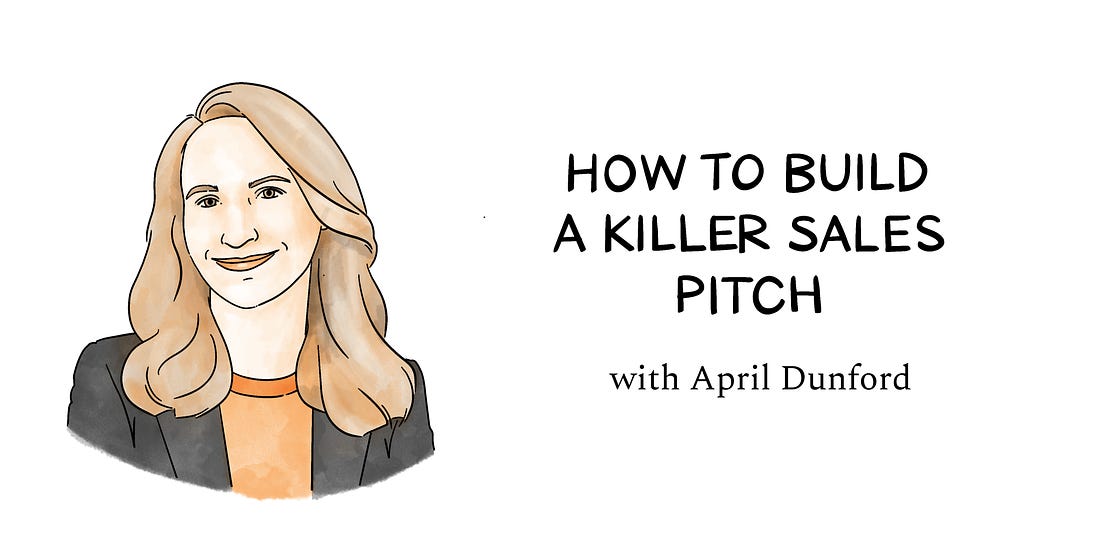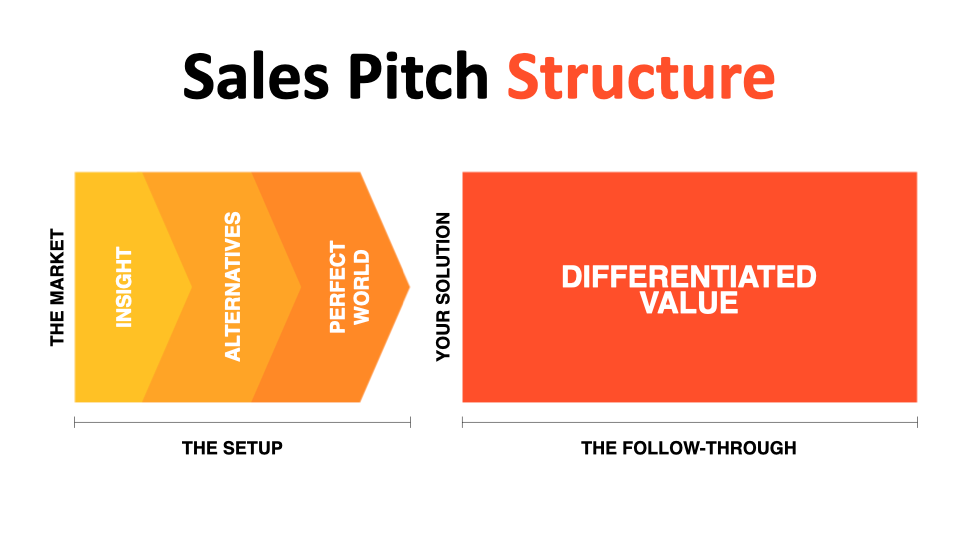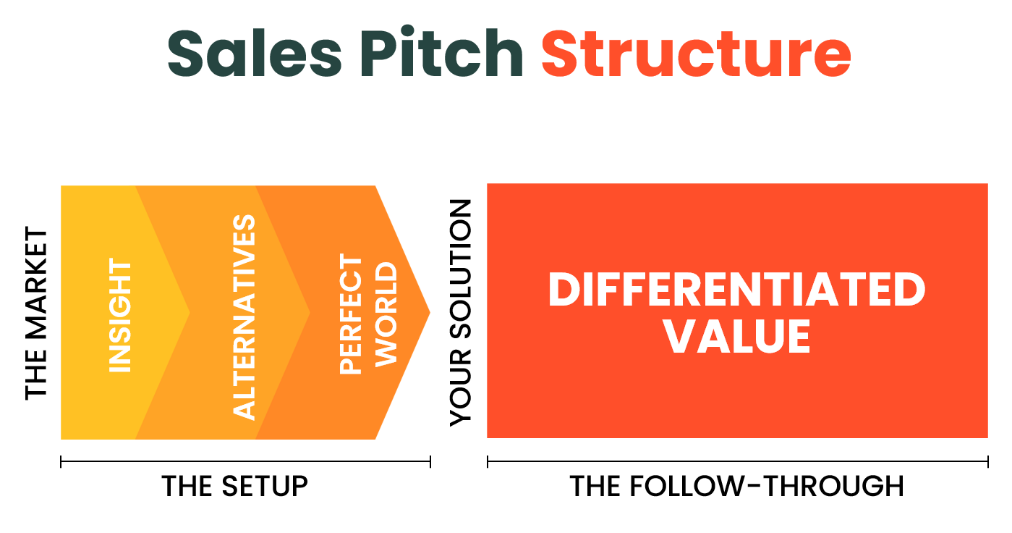Lenny's Newsletter - How to build a killer sales pitch
👋 Hey, I’m Lenny and welcome to a 🔒 subscriber-only edition 🔒 of my weekly newsletter. Each week I tackle reader questions about building product, driving growth, and accelerating your career. I suck at selling. I bet you do too. But that’s no excuse. We saw in last week’s post how important founder-led sales is in the early days of a startup, and as we’ll see in next week’s post, it only gets more important as you grow. Thus, I’m always on the lookout for actionable advice on how to get better at sales. When I heard that April Dunford (frequent collaborator, and author of the amazing bestseller Obviously Awesome) was working on a new book about sales, I knew it would be outstanding (it is). I convinced her to write a guest post sharing some of her best advice from the book. Per usual, she overdelivered. I suspect this post will transform how you pitch your product. Inside:
For more from April, do not miss her new book, Sales Pitch: How to Craft a Story to Stand Out and Win—it just came out this week! April also has a new podcast, where she shares bite-size lessons on positioning, marketing, sales, and standing out from the competition, and you can follow her on LinkedIn and X.  In Matthew Dixon and Ted McKenna’s new book, The JOLT Effect, they analyzed over 2 million sales calls looking for patterns that could teach us what works and doesn’t work in successful sales processes. One of their key findings was that 40% to 60% of B2B purchase processes result in “no decision.” And in the majority of the cases, the company didn’t decide to stick with the status quo because they decided it was better than other options. They failed to buy because they couldn’t figure out how to confidently make a decision. In B2B software, it turns out buyers are more worried about messing up than they are about missing out. Let’s understand why, and what we can do about it to significantly improve your sales success. Selling is hard, but buying is harderRather than focus on sales from our perspective as vendors, I’d like you to imagine what it’s like for a buyer. I think today, buying is harder—particularly if we are talking about B2B software. I’ve had folks laugh at me when I say that. They say things like, “April, that’s called shopping, and that’s not hard. I wish it was my job to buy stuff all day!” I get it—some things are fun to buy. I like shopping for shoes or T-shirts. But there are many things that are definitely not fun to buy. Have you ever bought insurance? How about a house? These are stressful purchases! Most of the things we love shopping for are low-stakes decisions, where there isn’t much of a problem if we make a poor choice. If I buy the wrong pack of mints at the convenience store, it’s not a big deal; I just won’t buy that one again. Insurance, on the other hand, is different. There are complex options to consider and, often, other people involved who could be impacted by the decision. If I make a poor choice, really bad things could happen. Many of the decisions that B2B technology buyers make are difficult because the stakes are high. A bad decision could lead to bad things for both the company and the buyer personally. Let’s look at a typical purchase process for an enterprise B2B product. A typical B2B purchase processJanet, the VP of Finance, has been struggling through an audit. She decides the company has outgrown its accounting software and they need to look at new options. Does she go looking for new accounting software to buy? Nope, she’s got an audit to deal with. She calls her controller, Joey, and says, “I need you to find us a new accounting software. Come back to me with a recommendation, and I will sign off on it.” How’s Joey feeling at this moment? He’s pissed! And a bit stressed. He doesn’t know much about accounting software. Sure, he uses the current platform, but he doesn’t know which the best accounting software vendors are or what the state of the art of accounting software is. He’s never purchased accounting software before in his life. Joey turns to the internet for help. He researches accounting software and finds hundreds of products, each with similar-sounding features and each claiming to be “The world’s best accounting software.” Comparison sites like G2 list a dozen “leading” software packages. There are hundreds of features to consider—some he understands, many he doesn’t. He signs up for a handful of trials, but he’s got questions that a trial can’t answer. How will this work during an audit? Will it integrate into our current IT stack and meet our security requirements? What about support for international offices? He books a demo with a shortlist of vendors, looking for answers. In each call, the sales rep asks Joey a bunch of questions about his requirements, his biggest challenges, and what he’s looking for. Joey answers as best he can, but he’s worried he doesn’t really know the answers. Are there other requirements he should be thinking about? The rep does a detailed product walkthrough demo, showing Joey dozens of product features. Joey’s not sure how important any of these are for his business and whether or not every new accounting package has them. At this point, Joey’s stress is peaking. What if he recommends a product to his boss and she hates it? What if the accounting team hates it and blames him for picking it? What if the product doesn’t have the audit capabilities needed and the company fails the audit? Joey could get passed up for a promotion. Heck, he might get fired. What is the easiest decision for Joey to make at this moment? The easiest thing for him to do is to go back to his boss and say, “Hey, now’s not a good time to switch accounting platforms; we have an audit to worry about, after all. What we have now isn’t perfect, but it’s fine. Let’s delay the decision until next year.” Delaying the decision gets Joey off the hook, and next year maybe he won’t be picked to figure out what package to buy. The origins of a better pitch structureMany of the B2B companies I work with use a pitch structure that is essentially a feature walkthrough. The sales rep logs in to the product and methodically takes the customer through as many features as they can cover in the time they have. There is little talk about which features are unique to the product and which are common to every solution on the market. It is left to the customer to determine why the features matter. There is rarely any talk about other potential approaches to the problem. In short, many sales pitches don’t do a great job of helping a prospect decide why they should choose your product over the alternatives. In the early days of my product marketing career, similar to Joey’s experience, I built pitches that were essentially detailed product walkthroughs. Sometimes we would throw in a company background slide, a case study, and sometimes a customer logo slide. If we were being really fancy, we would start with a “problem” slide before we moved to the product walkthrough (and in general, that problem was so vague, any of our competitors could also say they solved it). My perspective changed when I landed at IBM and had to build a sales pitch deck using their pitch structure. At IBM, our pitch structure was very specifically designed for IBM deals (which were gigantic, highly technical, and took an eternity to close), and some of the components were heavily influenced by The Challenger Sale. Not everything in the structure made sense for other companies, but there were two key things I thought could work anywhere. First, the pitch always started with IBM’s unique insight into the market, and, secondly, we never talked about features outside of the context of the value those features delivered for customers. The pitch was never about “pushing” our products on buyers. It was always about helping customers make confident purchase decisions. When I left IBM to join another startup, I stole these ideas and built a “startup-ified” pitch structure I could use to map positioning to a sales pitch. The new pitch dramatically improved revenue (and, ironically, led to us being acquired by IBM). I have now successfully used an evolving version of this pitch structure with over 200 B2B technology companies ranging in size from seed-stage startups to big companies like Google and Epic Games. I think it could help any company thinking about improving the way they communicate in sales meetings. Let’s dive in. A better sales pitch structureThe pitch structure is composed of two main parts: the setup and the follow-through. The setup is where we give customers a way to think about the entire market and get them aligned with our point of view. The follow-through is focused on our differentiated value and how we deliver that. At a very high level, the structure looks like this:  The “market insight” stage gives customers a way to think about the entire market so they can understand the trade-offs associated with different approaches and confidently make better decisions. Differentiated value (the value we can deliver to a customer’s business that nobody else can) is the core of our positioning, so it makes sense that it should form the core of our sales pitch. Let’s look at an example where we contrast a typical feature walkthrough with a more positioning-oriented pitch. Help Scout exampleBackgroundHelp Scout provides a customer service solution for modern digital businesses. Their point of view is that customer service is a growth driver, not a cost center. Traditional help-desk software treats service as a cost center and focuses on reducing time spent with agents. Help Scout was built for online businesses that do not have physical stores or salespeople, so support is one of the few places where customers interact directly with the company. For these businesses, delivering a great experience can strengthen customer loyalty, driving repeat purchases and revenue growth. Looking at the competitive landscape, many of Help Scout’s customers started by simply using a shared email inbox for support. As their business grows, these customers need a solution with more advanced features, like prioritization and assignments, leading them to look at traditional help-desk vendors. Let’s contrast a typical product walkthrough pitch with a pitch that mirrors Help Scout’s differentiated value. Feature walkthrough pitch for Help ScoutA feature walkthrough would flow like this:
The problem with this is that it appears there is a lot of overlap in the features that a shared inbox has and the features that a traditional help-desk solution has. Why pick Help Scout over the alternatives? It’s not entirely clear. A better sales pitch for Help ScoutUsing the improved sales pitch structure, the flow would look more like this:
This version of the pitch is entirely oriented around answering the question “Why pick us versus the other approaches?” Done well, the setup should take only a few minutes, but it is a crucial few minutes that helps to set the context for why our differentiated value matters to them. The setup phase should be a conversation with the prospect. At each step we are asking: Does this resonate with you? What are you folks using today? Have you considered other options? In sales, we call this discovery, and it is a critical point where the sales rep is getting a deeper understanding of the prospect’s situation and understanding of the market. A more detailed look at the setupLet’s break the setup down into the smaller components and then walk through another example:  The setup comprises three components: insight, alternatives, and “the perfect world.” 1. The insightThis is the most crucial step and also the hardest. Our insight underpins our point of view on the market. I like to think of it this way—what does a customer need to know in order to understand why our differentiated value is important? For Help Scout, it’s “Customer service is a growth driver, not a cost center.”... Subscribe to Lenny's Newsletter to read the rest.Become a paying subscriber of Lenny's Newsletter to get access to this post and other subscriber-only content. A subscription gets you:
|
Older messages
Inside Linear: Building with taste, craft, and focus | Karri Saarinen (co-founder, designer, CEO)
Sunday, October 8, 2023
Listen now (100 mins) | Brought to you by Mercury—the powerful and intuitive way for ambitious companies to bank | Composer—the AI-powered trading platform | Pendo—The all-in-one platform for product-
Brian Balfour: 10 lessons on career, growth, and life
Thursday, October 5, 2023
Listen now (102 mins) | Brought to you by Jira Product Discovery—Atlassian's new prioritization and roadmapping tool built for product teams | Coda—Meet the evolution of docs | Wix Studio—The web
Hiring your early team
Tuesday, October 3, 2023
Part six of my seven-part series on kickstarting and scaling a B2B business
What sets great teams apart | Lane Shackleton (CPO of Coda)
Sunday, October 1, 2023
Listen now (90 mins) | Brought to you by Eppo—Run reliable, impactful experiments | Vanta—Automate compliance. Simplify security | Ezra—The leading full-body cancer screening company — Lane Shackleton
Building Anchor, selling to Spotify, and lessons learned | Maya Prohovnik (Spotify’s Head of Podcast Product)
Thursday, September 28, 2023
Listen now (68 mins) | Brought to you by Sidebar—Catalyze your career with a Personal Board of Directors | Wix Studio—The web creation platform built for agencies | LinkedIn Ads—Reach professionals and
You Might Also Like
🚀 Ready to scale? Apply now for the TinySeed SaaS Accelerator
Friday, February 14, 2025
What could $120K+ in funding do for your business?
📂 How to find a technical cofounder
Friday, February 14, 2025
If you're a marketer looking to become a founder, this newsletter is for you. Starting a startup alone is hard. Very hard. Even as someone who learned to code, I still believe that the
AI Impact Curves
Friday, February 14, 2025
Tomasz Tunguz Venture Capitalist If you were forwarded this newsletter, and you'd like to receive it in the future, subscribe here. AI Impact Curves What is the impact of AI across different
15 Silicon Valley Startups Raised $302 Million - Week of February 10, 2025
Friday, February 14, 2025
💕 AI's Power Couple 💰 How Stablecoins Could Drive the Dollar 🚚 USPS Halts China Inbound Packages for 12 Hours 💲 No One Knows How to Price AI Tools 💰 Blackrock & G42 on Financing AI
The Rewrite and Hybrid Favoritism 🤫
Friday, February 14, 2025
Dogs, Yay. Humans, Nay͏ ͏ ͏ ͏ ͏ ͏ ͏ ͏ ͏ ͏ ͏ ͏ ͏ ͏ ͏ ͏ ͏ ͏ ͏ ͏ ͏ ͏ ͏ ͏ ͏ ͏ ͏ ͏ ͏ ͏ ͏ ͏ ͏ ͏ ͏ ͏ ͏ ͏ ͏ ͏ ͏ ͏ ͏ ͏ ͏ ͏ ͏ ͏ ͏ ͏ ͏ ͏ ͏ ͏ ͏ ͏ ͏ ͏ ͏ ͏
🦄 AI product creation marketplace
Friday, February 14, 2025
Arcade is an AI-powered platform and marketplace that lets you design and create custom products, like jewelry.
Crazy week
Friday, February 14, 2025
Crazy week. ͏ ͏ ͏ ͏ ͏ ͏ ͏ ͏ ͏ ͏ ͏ ͏ ͏ ͏ ͏ ͏ ͏ ͏ ͏ ͏ ͏ ͏ ͏ ͏ ͏ ͏ ͏ ͏ ͏ ͏ ͏ ͏ ͏ ͏ ͏ ͏ ͏ ͏ ͏ ͏ ͏ ͏ ͏ ͏ ͏ ͏ ͏ ͏ ͏ ͏ ͏ ͏ ͏ ͏ ͏ ͏ ͏ ͏ ͏ ͏ ͏ ͏ ͏ ͏ ͏ ͏ ͏ ͏ ͏ ͏ ͏ ͏ ͏ ͏ ͏ ͏ ͏ ͏ ͏ ͏ ͏ ͏ ͏ ͏ ͏ ͏ ͏ ͏ ͏ ͏ ͏ ͏ ͏ ͏ ͏
join me: 6 trends shaping the AI landscape in 2025
Friday, February 14, 2025
this is tomorrow Hi there, Isabelle here, Senior Editor & Analyst at CB Insights. Tomorrow, I'll be breaking down the biggest shifts in AI – from the M&A surge to the deals fueling the
Six Startups to Watch
Friday, February 14, 2025
AI wrappers, DNA sequencing, fintech super-apps, and more. ͏ ͏ ͏ ͏ ͏ ͏ ͏ ͏ ͏ ͏ ͏ ͏ ͏ ͏ ͏ ͏ ͏ ͏ ͏ ͏ ͏ ͏ ͏ ͏ ͏ ͏ ͏ ͏ ͏ ͏ ͏ ͏ ͏ ͏ ͏ ͏ ͏ ͏ ͏ ͏ ͏ ͏ ͏ ͏ ͏ ͏ ͏ ͏ ͏ ͏ ͏ ͏ ͏ ͏ ͏ ͏ ͏ ͏ ͏ ͏ ͏ ͏ ͏ ͏ ͏ ͏ ͏ ͏ ͏ ͏ ͏
How Will AI-Native Games Work? Well, Now We Know.
Friday, February 14, 2025
A Deep Dive Into Simcluster ͏ ͏ ͏ ͏ ͏ ͏ ͏ ͏ ͏ ͏ ͏ ͏ ͏ ͏ ͏ ͏ ͏ ͏ ͏ ͏ ͏ ͏ ͏ ͏ ͏ ͏ ͏ ͏ ͏ ͏ ͏ ͏ ͏ ͏ ͏ ͏ ͏ ͏ ͏ ͏ ͏ ͏ ͏ ͏ ͏ ͏ ͏ ͏ ͏ ͏ ͏ ͏ ͏ ͏ ͏ ͏ ͏ ͏ ͏ ͏ ͏ ͏ ͏ ͏ ͏ ͏ ͏ ͏ ͏ ͏ ͏ ͏ ͏ ͏ ͏ ͏ ͏ ͏ ͏ ͏ ͏ ͏ ͏ ͏ ͏ ͏ ͏
